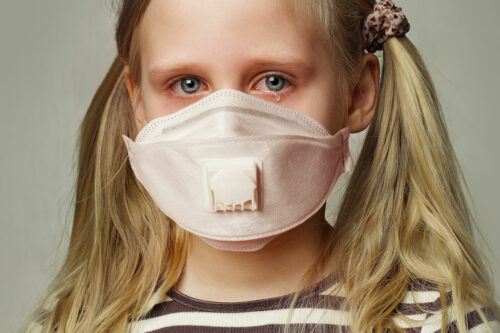In early 2020, the pandemic response team implemented COVID-19 policies in order to help stop infection and transmission of the virus. Lockdowns and masks were mandated despite the fact that they had no scientific evidence to back them up. Not only these edicts didn’t help stop transmission or infection but caused more harm than good. Let’s explore masks.
The Ineffectiveness of Masks
Wearing masks for long periods provides virtually no protection against the virus. The following are just a few of the hundreds of studies showing the inefficacy of masks.
- The New England Journal of Medicine reported that masking in close settings reduces the risk of catching the virus only slightly. This is because droplets may enter the eyes, as well as oral and nasal passages. Plus, contaminated objects may be picked up on the hands and carried to mucous membranes – even more since mask wearers have an increased tendency to touch their faces. Masks don’t protect from SARS-CoV-2 unless accompanied by meticulous hand hygiene, eye protection, as well as gown and glove wearing.
- A critical review of facemask efficacy showed that evidence is inadequate to demonstrate a clear benefit. Previous studies supporting the beneficial effects of facemasks are based on assumptions that virus transmission is reduced by 40–50%; yet, existing data doesn’t support those assumptions.
- A study of mask mandates at a hospital showed that there was no reduction in per-population daily mortality, hospital beds, ICU beds, or ventilator occupancy of COVID-19-positive patients after implementing mask mandates.
- Research comparing US states showed that statewide mask mandates and mask use were not associated with lower COVID-19 case growth rates.
- A study from Finland showed that the use of face masks did not impact the incidence of COVID-19 in 10 to 12-year-olds in school.
- A review of the clinical effectiveness of using surgical masks in the operating room found no evidence that masks protect staff from infectious materials.
- A randomized controlled trial evaluated the use of facemasks against confirmed viral respiratory tract infections and found that facemask use does not prevent clinical or laboratory-confirmed viral respiratory infections.
- A randomized controlled trial in healthcare workers found that the rate of all infection outcomes was 97% when wearing cloth masks and 44% when wearing medical masks – clinical respiratory illness, influenza-like illness, and laboratory-confirmed respiratory virus infection were some of the conditions found.
- A randomized clinical trial of 2862 healthcare workers showed that there was no significant difference between N95 respirators vs medical masks. Despite mask-wearing, 55% got an acute respiratory illness in the respirator group vs 60% in the mask group, and 4.5% got influenzalike illness events in the respirator group vs 5.8% in the mask group.
You can also figure out masks’ protective effects by considering the physicality of the virus and masks. SARS-CoV-2 is 0.125 microns in size. Surgical and cloth masks can filter down particles 15-30 microns and bigger, and N95 respirators can only filter down particles sized 0.3 microns and bigger. Masks can only filter down particles that are larger than the virus. Since the filtration capacity of masks can’t filtrate virus-size particles, you can deduce that masks do not offer a real barrier or physical covering to prevent the virus from getting in!
Masks’ Adverse Effects
Masks not only do not protect you against the virus, but they pose risks to your health. Plus, continued mask-wearing causes irreversible damage to younger generations.

Here are some of the most common adverse effects associated with masking:
- Long-term mask use poses a serious danger for developing Mask-Induced Exhaustion Syndrome (MIES): MIES increases breathing resistance, carbon dioxide levels in the blood, heart rate, blood pressure, and shortness of breath. It decreases oxygen levels in the blood and cardiopulmonary capacity. MIES is associated with hypoxia, dizziness, toxicity, inflammation, increased stress hormone levels, anxiety, anger, headache, slow thinking, and drowsiness.
- Studies show that masking is not optimal in school settings as it “reduces the ability to communicate, interpret, and mimic the expressions of those with whom we interact. Positive emotions become less recognizable, and negative emotions are amplified.”
- Research shows that masks limit people’s ability to infer emotions expressed by facial features. Furthermore, mask use in younger children (ages 3 to 5) produces significant problems and can affect social development and emotional reasoning. Plus, it affects children’s interactions and mental health.
- Research also shows negative skin outcomes related to masking: skin irritation, moisture build-up, face warmth, itch, redness/erythema, dermatitis, rash, xerosis, burning, and pain/prickling.
- Wearing masks for long periods puts you at risk of bacterial flora changes in the mouth which can cause bad breath, tooth decay, digestive problems, inflammation, pneumonia, black fungus, and lowered immune system responses.
- A study of masks showed high rates of contamination, 70% of masks showed fungal contamination, 52% showed contamination with Aspergillus sp.
- Research shows that face masks have titanium dioxide (TiO2) nano)particles – a human carcinogen when inhaled. The total TiO2 mass per mask ranges from 791 to 152,345 µg, and the estimated TiO2 mass at the fiber surface ranged from 17 to 4394 µg. TiO2 in masks exceeds the acceptable exposure level to TiO2 by inhalation (3.6 µg) so prolonged use of masks is not recommended.
Following the Science?
When you ask honest and ethical doctors to explain masks. They say that they wear masks in the operating room as a courtesy. They wear masks in case they sneeze or cough while their hands are busy examining patients. The goal is to use them to avoid sneezing or coughing all over patients, not to protect themselves from getting sick. If you recall, you never saw doctors or nurses wearing masks during your routine doctor visits pre-2020, not even during flu season. This is because science didn’t justify mask-wearing.
At the beginning of the pandemic, Fauci said, “when you are in the middle of the pandemic, wearing a mask might make people feel better and might even block a droplet but it’s not providing perfect protection.”
A year later, Fauci was pushing for double masking. He said one mask offers “a physical covering to prevent droplets and viruses to get in… when you put another layer, it makes common sense that it’d likely be more effective.”
How is it possible that the director of the National Institute of Allergies and Infectious Disease, who has been in the public health arena for over forty years keeps making completely opposing statements?
Just like there was no evidence to support lockdowns, there was no scientific support for mask-wearing. Masking is not an effective tool for preventing infection or transmission of SARS-CoV-2. We have hundreds of studies on masks’ ineffectiveness and harm to prove it. The latest meta-study from early 2023, which evaluated dozens of studies on masks, concluded that confidence in the effect of masks is limited. Studies didn’t ‘show a clear reduction in respiratory viral infection with the use of medical/surgical masks and there were no differences between the use of medical/surgical masks compared with N95/P2 respirators.”
Masks’ Role
Governments mandated masking in public places in order to, at some point, allow us to go back to our “normal” lives. Everyone had to be muzzled while being in public places. Children were forced to wear masks to attend school even though children don’t drive the spread of the SARS-CoV-2 virus. Children, also, have virtually zero chance of dying except in extremely rare circumstances. In NYC, the mask mandate for children was lifted in June of 2022 – our children were muzzled for 3 years!
Fauci and the powers that be realized the potent effect of masking citizens. Mask mandates served several purposes:
- Masking citizens was a powerful means of control. It was a symbol of submission and a way to nudge people to remain quiet.
- Masking served as a solution – even though it was ineffective. After terrifying us with death counts and fraudulent reports about the fatality of the virus, they needed to present themselves as saviors. They gave us masks for our “protection.” This was part of the protocol that decreased anxiety in many.
- At the same time, masking served as a mechanism of identification. Authorities were able to identify their apostles – those who followed without questioning. Simultaneously, they engaged the masses so people would be able to identify those who weren’t compliant, those who were “not doing their part,” and those who were “putting people at risk.” Consequently, those who were not following the slogan, “we’re all in this together,” were easily detectable so the masses could punish them.
Mask mandates were another Covid-19 policy that harmed Americans. It wasn’t health policy based on science. It was never about reducing infection or transmission of SARS-CoV-2. The only benefit of masks was their symbolic illusion of safety. Yet, the forced institution of masks was a mechanism of totalitarian control and a hack to divide the masses.
To a Fitter Healthier You,
The Fitness Wellness Mentor



